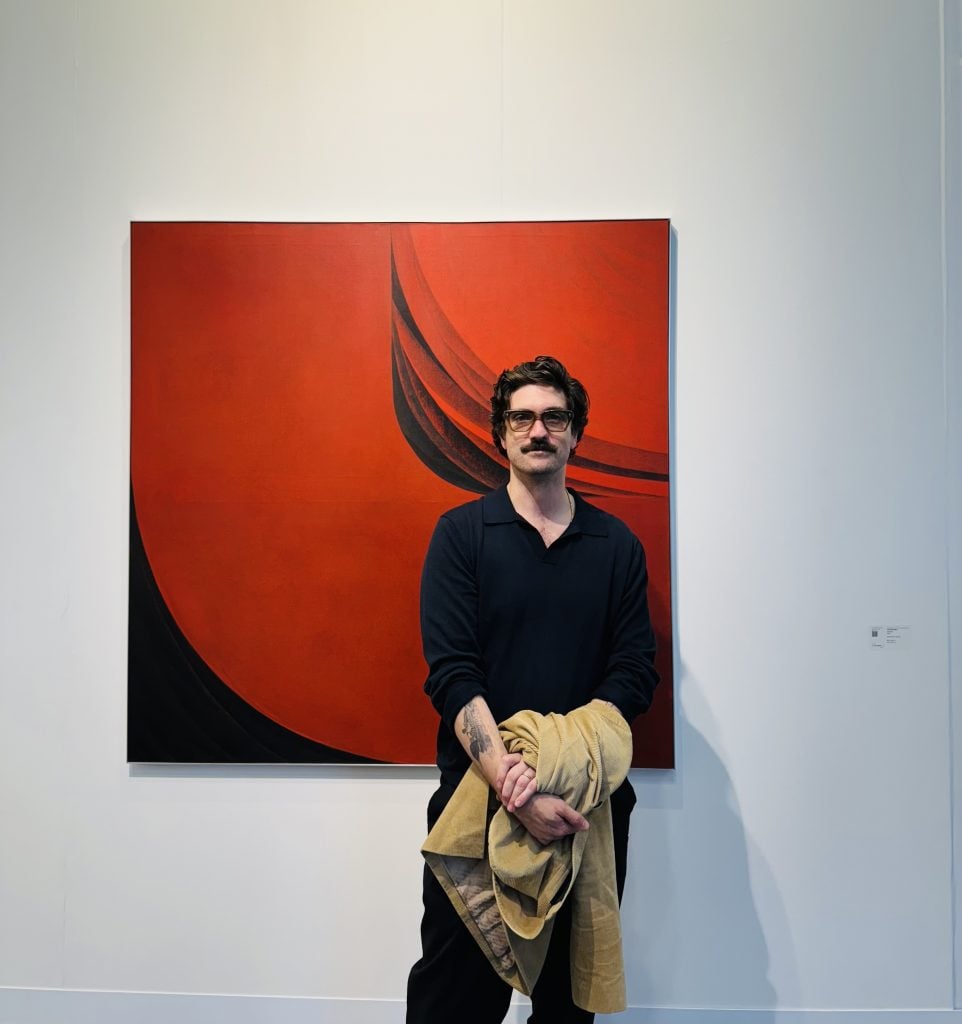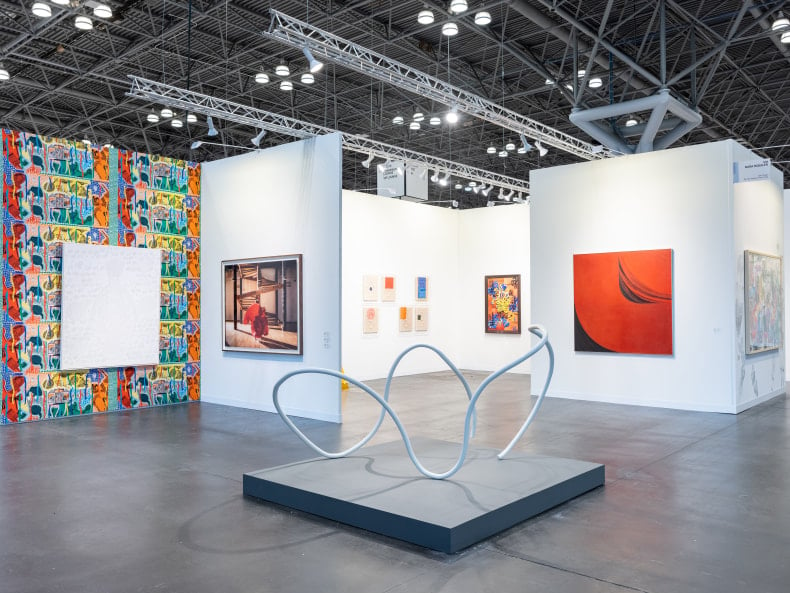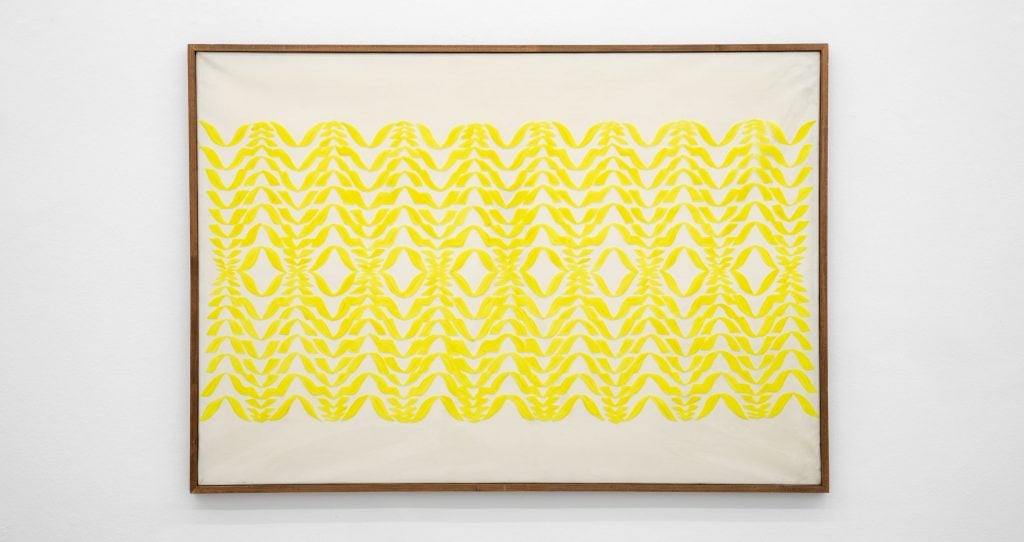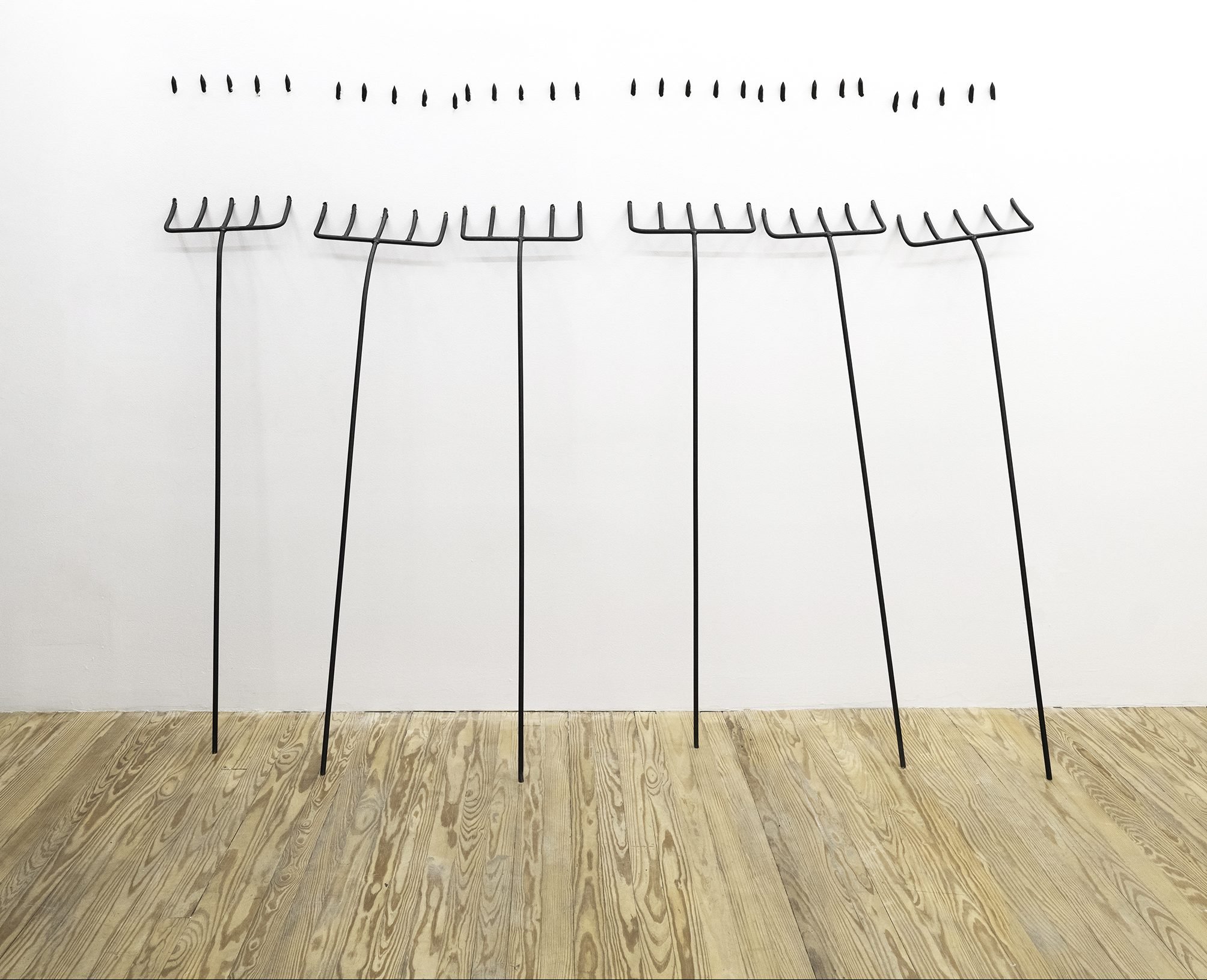Art Fairs
From Pitchforks to Japanese-Brazilian Minimalism, What Caught James Cardoso Shaeffer’s Eye at Armory
We journey to the Javits Center and take a tour of the 2024 Armory Show with the art advisor and GEMS gallerist.

It was mid-afternoon at yesterday’s VIP preview at the Armory Show when the art advisor and curator James Cardoso Shaeffer came prepared to navigate the labyrinthine Javits Center. Cardoso Shaeffer is the mind behind GEMS, the Lower East Side non-gallery gallery. He opened the experimental space after stints at James Fuentes, Simon Lee, and Greene Naftali.
Cardoso Shaeffer, mustachioed and sporting thick-brimmed taupe Jacques Marie Mage eyeglasses (he credits his wife Danielle Cardoso Shaeffer, a director at Gagosian, for chic-ifying him) greeted me with a hug before we set off down the fair’s corridors. He’s keen to see how the fair has evolved under the new director Kyla McMillan. “She has worked for the best galleries – Gavin Brown, Zwirner, she had her own gallery,” he said. “She’s just a badass. I think that she’s coming in with a perspective that isn’t aligned with the status quo, so I’m interested to see what she’s going to do.”

Nara Roesler’s booth at the Armory show. Courtesy of the gallery.
Our first stop was the Nara Roesler booth, a gallery with locations in Chelsea as well as São Paulo and Rio de Janeiro. Cardoso Shaeffer was drawn to an abstract black and red painting by Tomie Ohtake that is reminiscent of desert dunes, with a seductive shadowplay dappling the painting’s open spaces. Ohtake, who died at 101 years old, was part of Brazil’s large Japanese diaspora.
“We got into her market five years ago,” Cardoso Shaeffer said. “I’m fortunate enough to have a wife who’s from Brazil. So, Danielle introduced me to her work. It was right at this tipping point where a lot of people started to look at overlooked female artists and artists of color. She hit that confluence. On top of that, she’s a fucking good artist. It really wasn’t until the last decade that people north of the equator started looking at her work. Since then the Guggenheim Abu Dhabi acquired a piece, and a major museum in New York has acquired a piece, but that’s not public yet.” Ohtake has also factored into his advisory. “I placed a few of these with some clients five years ago,” he said.

Installation view, The Armory Show 2024, Victoria Miro, Booth229, Javits Center, New York. All artworks © Isaac Julien. Courtesy the artist and Victoria Miro.
Next, Cardoso Shaeffer headed to the nearby Victoria Miro booth. Its space was devoted to an Isaac Julien video installation Once Again… Statues Never Die. The work was also shown at this year’s Whitney Biennial. At the booth, a sequestered, mirrored room displays black and white videos on two juxtaposed screens. The work explores the connection between Dr. Albert C. Barnes, an early American collector and exhibitor of African art and cultural artifacts, and Alain Locke, the renowned philosopher and cultural critic known as the ‘Father of the Harlem Renaissance.’
“This is the only meaningful, good installation at the fair,” Cardoso Shaeffer opined. “The work is emotive, even if this isn’t the first thing that I would gravitate to at the fair. The gallery has clients for this, unless they have no private institutions. It still is something that shows an artist taking a risk within a commercial setting. Also, this wasn’t cheap to put up, so it’s admirable to be able to show people that art can also be something that is just inherently self indulgent.”
As we ambled to our next destination, the energy in the center was picking up. Cardoso Shaeffer wanted to introduce me to the gallerist at the Galleria Massimo Minini, but he was in rapt conversation with an art advisor and her clients, possibly mid-deal, so we dared not interrupt. “He’s talking to money people,” Cardoso Shaeffer whispered, and then proceeded to tell me about an artist represented by the gallery whom he’s geeked out over. The artwork he wanted to show me isn’t on display at the booth, but is within the gallery’s collection, so he pulls it up on his phone.

Carla Accardi, Giallo-Bianco (1966). Courtesy of Galleria Massimo Minini.
“Carla Accardi is another overlooked female artist,” Cardoso Shaeffer explained, and displayed an image of Giallo-Bianco (1966), which entails rows of undulating yellow lines zig-zagging across a canvas to form an almost psychedelic pattern. “She was making this near geometric style of abstract painting using new materials. Acrylic paint is relatively a brand new medium she was bringing to the forefront. This piece is made with varnish and Sicofoil, a new kind of packaging plastic at the time. Like, this a few years before Sol Lewitt was making these same pattern pieces. You know, you can’t really like dangle keys in front of somebody. No one really cared about her in America except for the nerds. Collectors that are coming to this gallery today are more likely to be into this these days. Good collectors are listening to the nerds.”
As we walked, a model in a hot pink pixie wig passed by with a neon sign strapped to her torso that we did not bother to read. I posed the big question: Is GEMS the format of the gallery of the future?
“I only wanted to have a physical space for a year,” he said. “Now I’m gonna start transitioning to doing exhibitions at collector’s homes. I have an exhibition with my friend Andrew J. Greene coming up, but then I’m also working on other shows that are happening. I have something down the pipeline with Mike Kelly.” The crux of Cardoso Shaeffer’s philosophy is bristling against and evolving beyond the traditional gallery system.
“People have this sublime fear,” Cardoso Shaeffer chuckled. “‘We need to sell this many artworks because we have this much overhead,’ and if we don’t make that overhead, then the gallery shuts down. We can no longer support artists, so artists can no longer do what they want to do. The only way they can ever get to do what they want to do is if they are represented by a major gallery and they have an institutional show, then they can do whatever the fuck they want.”
He added, “Look at the Christopher Wool show from this summer. It was in an empty office space in a high rise, and he did it himself. That’s the future.”

Maggie Dunlap, The Horseman’s Word 1-6 (2024) Courtesy of No Gallery
The local Lower East Side No Gallery’s booth was Cardoso Shaeffer’s final destination. “The reason why I love this booth is that I think the ethos of the gallery is amazing,” he said. “No Gallery, which kind of tells you enough about what it is. Casey Gleghorn is like a former punk. He’s been around the scene for a while. We met after I did the first show with GEMS, which was just this gigantic inflatable wave by Gedi Sibony stuffed in the gallery. He came in and said ‘I wanted to say hi, because anyone that’s doing something that’s 100% not gonna sell, that’s my guy.’
At the booth, one wall displayed Maggie Dunlap’s The Horseman’s Word 1-6, a haunting installation that looks like six pitchforks have been gouged through the booth’s wall. (In actuality, the prong tips are separated and glued). “In the original show, they were literally stuck into the gallery wall and poked out the other side,” Cardoso Shaeffer said. “ I think it sold in the very end. That’s the type of collector that we’re interested in, because that’s the same collector that took chances on abstract painting when it came out, that took chances on Impressionism.”





